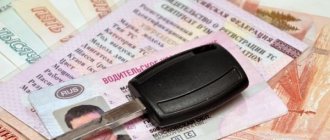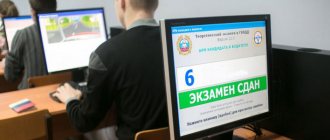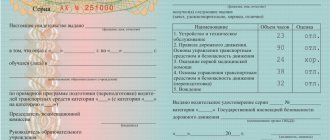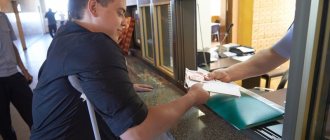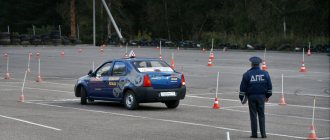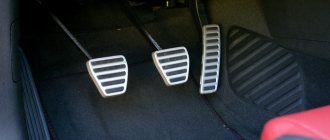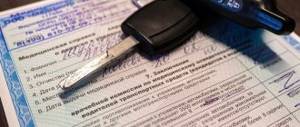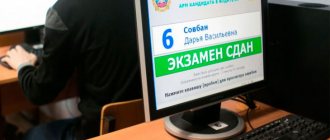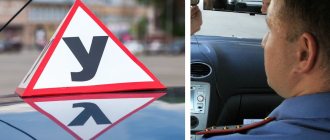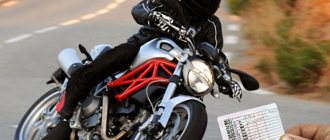What will happen in the theory exam at the traffic police
There are 20 theory questions in one ticket. The exam is considered passed if the examinee answers at least 18 correctly. The ticket includes questions of different categories:
- general provisions;
- road signs;
- road markings;
- traffic lights and traffic controller signals;
- starting to move, maneuvering;
- movement speed;
- overtaking, advancing, oncoming traffic;
- stopping and parking;
- driving through intersections;
- use of external lighting devices and sound signals;
- malfunctions and conditions for admitting the vehicle to operation;
- traffic safety and driving techniques;
- provision of pre-hospital medical care;
- general responsibilities of drivers;
- location of the vehicle on the roadway;
- priority of route vehicles;
- towing mechanical vehicles;
- use of special signals;
- driving on highways;
- training riding and additional requirements for the movement of cyclists;
- traffic in residential areas;
- movement across railway tracks;
- pedestrian crossings and stopping places for route vehicles;
- transportation of people and goods;
- driver responsibility;
- use of hazard warning lights and warning triangles.
The ticket often contains all categories of questions, that is, the first may relate to the topic “Transportation of people and goods,” the second to “Traffic safety and driving techniques,” etc.
Most questions contain illustrations that present traffic situations or show signs. All tickets are test tickets with a choice of answers, you need to choose only one correct one.
The main difficulty is that the examinee inattentively looks or does not pay attention to the words “allowed” and “not allowed”. Also, most errors are caused by tickets with the answer “in both cases,” when both options are correct, but the student is in a hurry and indicates only one correct answer.
Also read: Types of road signs
Driving in the city
After the inspector checks the condition of the car, you will be invited to take an exam. The inspector will introduce you to the procedure and evaluation system for the exam results.
There are an inspector and a student in the car. And if the car belongs to a driving school, then a third person may be present - the instructor of your driving school.
At the inspector's command, get behind the wheel and prepare the car to start driving. Don't forget to adjust the driver's seat and rear view mirrors. After this, we show our passport to the video surveillance system.
If it's raining or snowing outside, be sure to turn on the heated rear window and air conditioning!
We start the engine, fasten the seat belt, turn on the low beam headlights and release the parking brake. We look in the rearview mirrors, assess the situation, turn on the appropriate turn signal and drive off.
As instructed by the inspector, you must perform the following maneuvers:
- Drive through an unregulated intersection of unequal roads.
- Drive through a controlled (with traffic light) intersection of equivalent roads.
- Make a U-turn at and outside the intersection.
- Change lanes on a road with two or more lanes.
- Make an overtake.
- At the request of the inspector, drive at the maximum speed limit.
- Go through the pedestrian crossing.
- Drive through a railroad crossing.
For mistakes while driving around the city, the student is awarded penalty points: 5 points for making a gross mistake, 3 points for making a medium mistake, 1 point for making a minor mistake.
The exam is considered passed if the student made no mistakes or scored less than 5 penalty points. If the sum of penalty points is 5 or more, then the exam is not passed.
The exam in the city can last up to 30 minutes. Whether you ride for 30 minutes or less depends on the inspector.
Typical mistakes that students make when driving in the city:
- The student started moving without the inspector's command.
- The inspector gave the command to turn at the nearest signalized intersection. The student simply makes a turn at the nearest intersection, although it may be unregulated. Therefore, listen carefully to what the inspector says, since often tasks have a catch.
- At a controlled intersection, a student makes a U-turn at a pedestrian crossing and, when turning, hits the markings of the pedestrian crossing. Therefore, drive a little further onto the road so as not to hit the markings.
- The student forgot to turn on the turn signal.
- The student lined up across the solid line. Typically, examiners give such tasks with a trick when you approach an intersection or pedestrian crossing.
Useful tips on how to pass your driving test in the city
- First gear is only for getting going! As soon as you drive, engage second gear.
- On slopes, start moving only with the handbrake.
- When turning and changing lanes, do not forget to turn on your turn signals.
- Shift gears in a timely manner. Do not drive in low gears or high revs.
- Let pedestrians pass even when they are just approaching the zebra crossing.
- Do not ignore the examiner's instructions, but follow them carefully in accordance with the rules of the road. If the situation on the road forces you to break the rules, warn the examiner, then this will not be considered a violation. If he gives a negative answer, then proceed according to the traffic rules.
- Each examination machine has 4 video cameras. This was done so that you could prove that the inspector failed you in the exam. Therefore, when the examiner gives you commands, repeat his words to the camera. If controversial situations arise, you will have evidence.
- According to the new rules, exams can be taken at the place of application. If you are from a big city and have the opportunity to take the exam in a small town, then do not miss this opportunity. It's much easier to pass your driving test in a small town. Usually there are few streets there, there is no large flow of cars, there are practically no traffic lights and multi-lane highways with interchanges.
How the theory exam is conducted
Submission of the theory to the traffic police occurs as follows. A group of examinees enter a classroom to take a computer-based test. The exam can also take the form of a test on a special form.
The test has 20 questions. Each of them contains answer options. The examinee must select only one by checking the box on the computer or on the form. It is not necessary to follow the order of questions. You can answer easy questions first, then difficult ones, at your discretion. To eliminate errors in computer testing, the answer is accepted by the PC only when pressed twice.
The time allotted for passing the theoretical exam at the traffic police is 30 minutes.
Most test takers experience anxiety and uncertainty. The main thing to remember is that there are 800 exam questions in total. If you have everything sorted out and have taken online tests multiple times in preparation for passing the theory, everything will work out. At the traffic police exam there will be nothing new on the tickets, just as there will be no oral questions or other unscheduled moments. All theory tickets are the same throughout Russia.
Also read: How to sign up for a traffic police exam
What you need to pass the exam successfully
To significantly increase your chances of successfully passing the theoretical exam in the traffic police, you need to pay attention to the following points:
- Learn the theory of traffic rules by heart. We remember our school years and begin to delve into the features. Some questions may seem very difficult. To learn in such cases, we recommend that you analyze the question, study it thoroughly and try not just to memorize it, but to understand the essence. Then it will be easy for you to navigate during the exam.
- Ability to use computer technology will be an advantage. We are no longer in the “paper” age - the era of computers has come a long time ago. The traffic police exam can be taken on a computer.
- Behave with restraint and calm. If you feel that you are unable to concentrate due to anxiety, take a mild sedative that does not have a sleeping effect. You don't want to scare everyone in the class with your snoring, do you?
- Pay special attention to difficult theoretical issues. There are questions that are remembered the first time, but some, on the contrary, are not remembered for the life of us. These are the ones we work with. We are trying to identify a pattern and, as already said, memorize it.
- Take online tests at home. Textbooks are a good thing, but practice at home using online trainers, of which there are now many on the Internet.
Nikita Orlov, auto expert:
«The theoretical exam in the traffic police is certainly not as important as practical driving skills. At the same time, without passing the theory, you simply will not be allowed to practice. Many people try to “memorize” traffic rules or exam papers, but this is pointless. You need to not only know the traffic rules, but also understand them. Do not try to guess the answer on the exam card, much less remember the point of the rules regulating the situation. The most effective training method will be the assistance of an existing driver. Ask parents or friends who already have a driver's license to go over with you those tickets that are particularly problematic. Only by understanding the principle of applying traffic rules in practice will you catch luck by the tail in the theoretical exam.”
Also read: Rules for retaking the traffic police exam
How to deal with anxiety
We have a whole article dedicated to how to pass the traffic police exam without worry.
- Set yourself up for a positive outcome. Even if you don't pass the first time, you still have many more attempts ahead.
- Talk to the examiner in a friendly manner and do not cheat your license. The inspector is also a person!
- A lot depends on your preparation for the exam. Therefore, the most important thing is to learn the rules of the road by heart! The better you prepare, the less you will worry about the exam. And the less you worry, the more successfully you will pass it.
- The night before the exam, do not drink alcoholic beverages, and do not take sedatives in the morning. Since all this will not have the best effect on your attention.
- Get a good night's sleep the night before the exam.
- Examine your weaknesses. Maybe you have trouble parking or shifting gears incorrectly. Work hard on your shortcomings a few days before the exam.
- Drive several times along the exam route where the practical exam will take place. There will definitely be places that are difficult to navigate and you should study them in advance.
- If you make a mistake while driving, don’t be upset and keep driving. One mistake doesn't mean anything.
If you have any questions, ask them in the comments, you can also ask them through an online consultant or call us at +7.
Share on social networks:
More useful on the topic
How to properly start a manual vehicle: step-by-step instructions for beginners
23.05.2021
How to properly adjust the side and interior mirrors of a car yourself
08.04.2021
Common mistakes
In most situations, when a cadet cannot pass the theory the first time, the reason is ignorance of the questions, inattention and haste:
- Inattention. Pay special attention to the words “prohibited” and “allowed.” For some reason, these words are most often confused, although they have opposite meanings.
- Rush. Once you sit down at the computer, strictly follow the instructions of the traffic police officer. You should not rush and press buttons, because the program can complete the test without starting it.
- Ignorance. Most cadets make mistakes on questions related to intersections, traffic controllers and trams. Study these questions thoroughly and take your time when answering them.
To avoid mistakes, use didactic materials and practice more often. Only when you feel that you are answering questions not just automatically, but with an understanding of what is required of you in the question, will you feel confident and will not make mistakes. Don't be afraid that you won't have enough time. 30 minutes is enough to read and answer 20 questions on the ticket. To make sure of this, time yourself when you study at home.
Also read: List of mistakes in the city and penalty points for them

